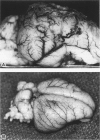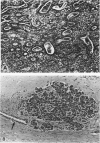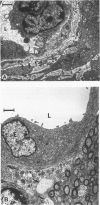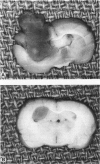Abstract
Microvascular proliferation, a hallmark of malignant brain tumors, represents an attractive target of anticancer research, especially because of the quiescent nonproliferative endothelium of the normal brain. Cerebral neoplasms sequester copper, a trace metal that modulates angiogenesis. Using a rabbit brain tumor model, normocupremic animals developed large vascularized VX2 carcinomas. By contrast, small, circumscribed, relatively avascular tumors were found in the brains of rabbits copper-depleted by diet and penicillamine treatment (CDPT). The CDPT rabbits showed a significant decrease in serum copper, copper staining of tumor cell nuclei, microvascular density, the tumor volume, endothelial cell turnover, and an increase in the vascular permeability (breakdown of the blood-brain barrier), as well as peritumoral brain edema. In non-tumor-bearing animals, CDPT did not alter the vascular permeability or the brain water content. CDPT also inhibited the intracerebral growth of the 9L gliosarcoma in F-344 rats, with a similar increase of the peritumoral vascular permeability and the brain water content. CDPT failed to inhibit tumor growth and the vascularization of the VX2 carcinoma in the thigh muscle or the metastases to the lung, findings that may reflect regional differences in the responsiveness of the endothelium, the distribution of copper, or the activity of cuproenzymes. Metabolic and pharmacologic withdrawal of copper suppresses intracerebral tumor angiogenesis; angiosuppression is a novel biologic response modifier for the in situ control of tumor growth in the brain.
Full text
PDF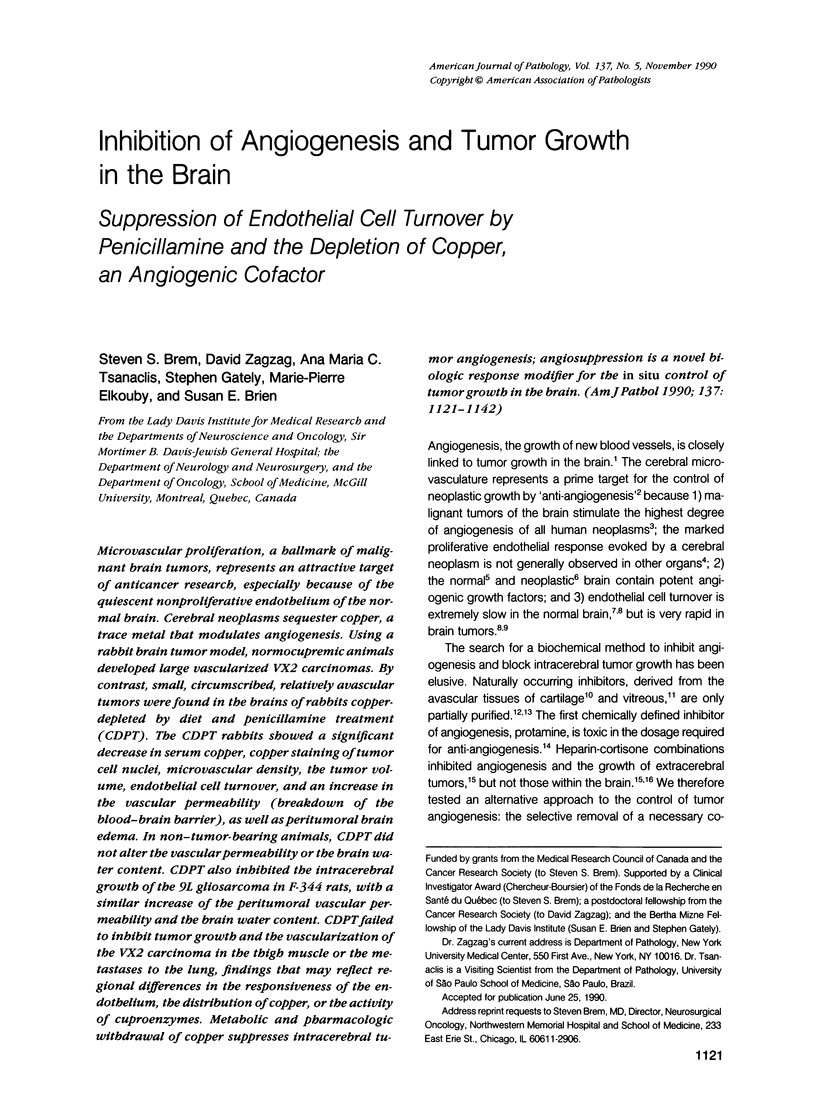
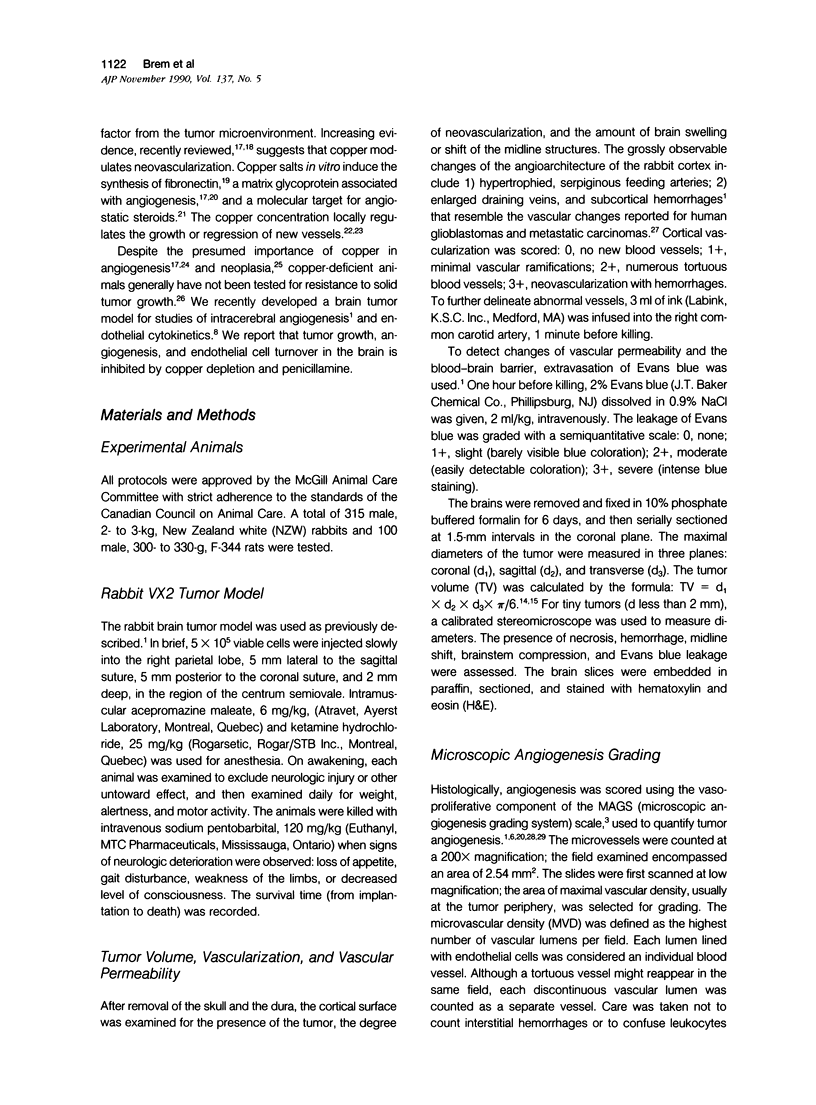
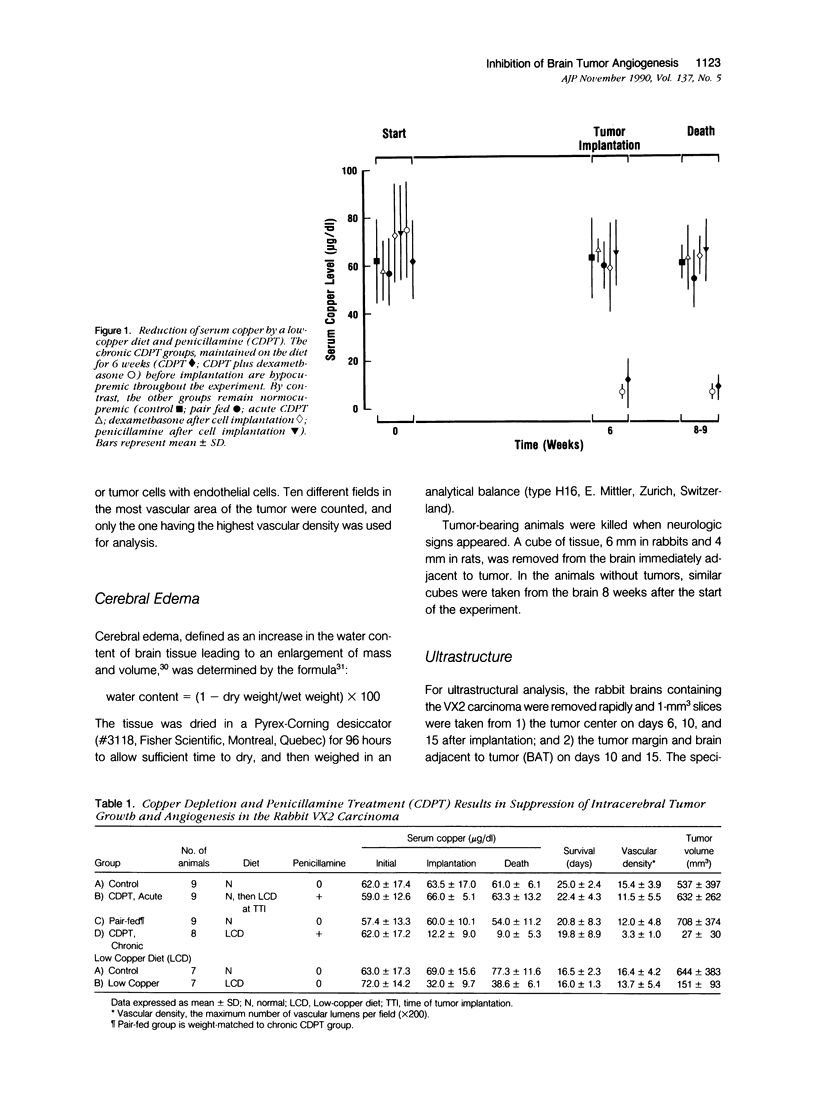
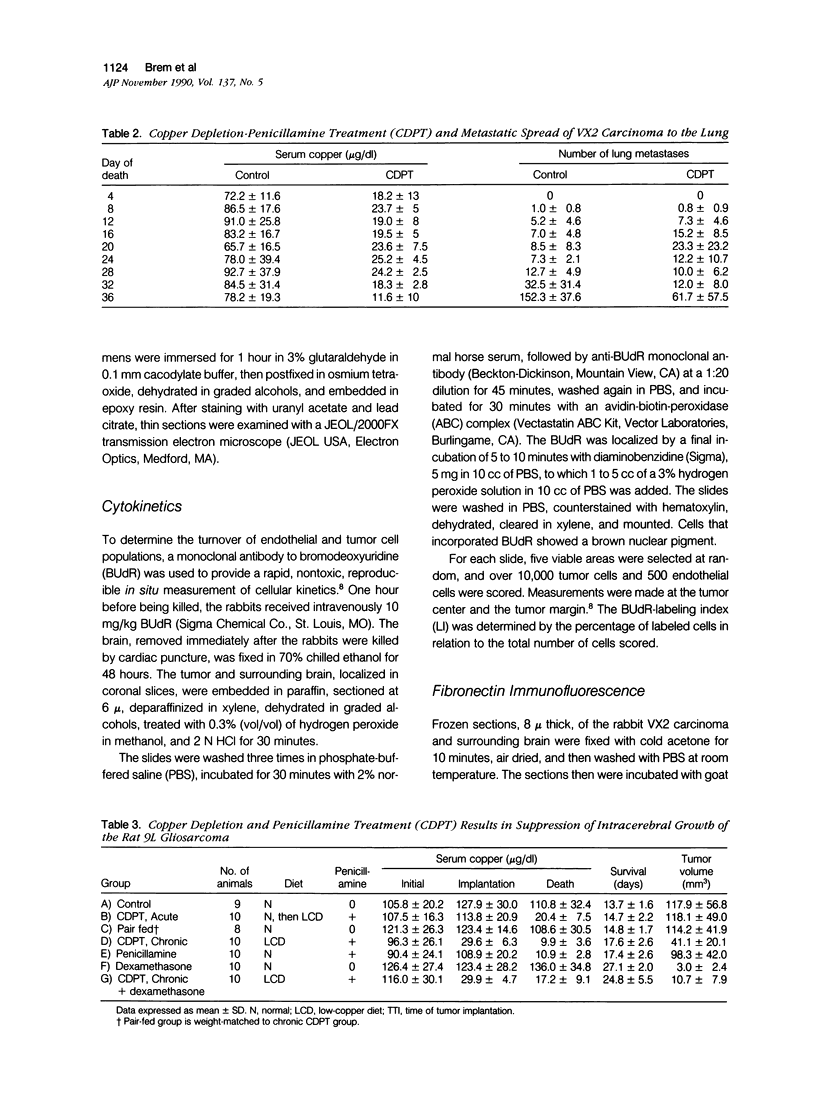
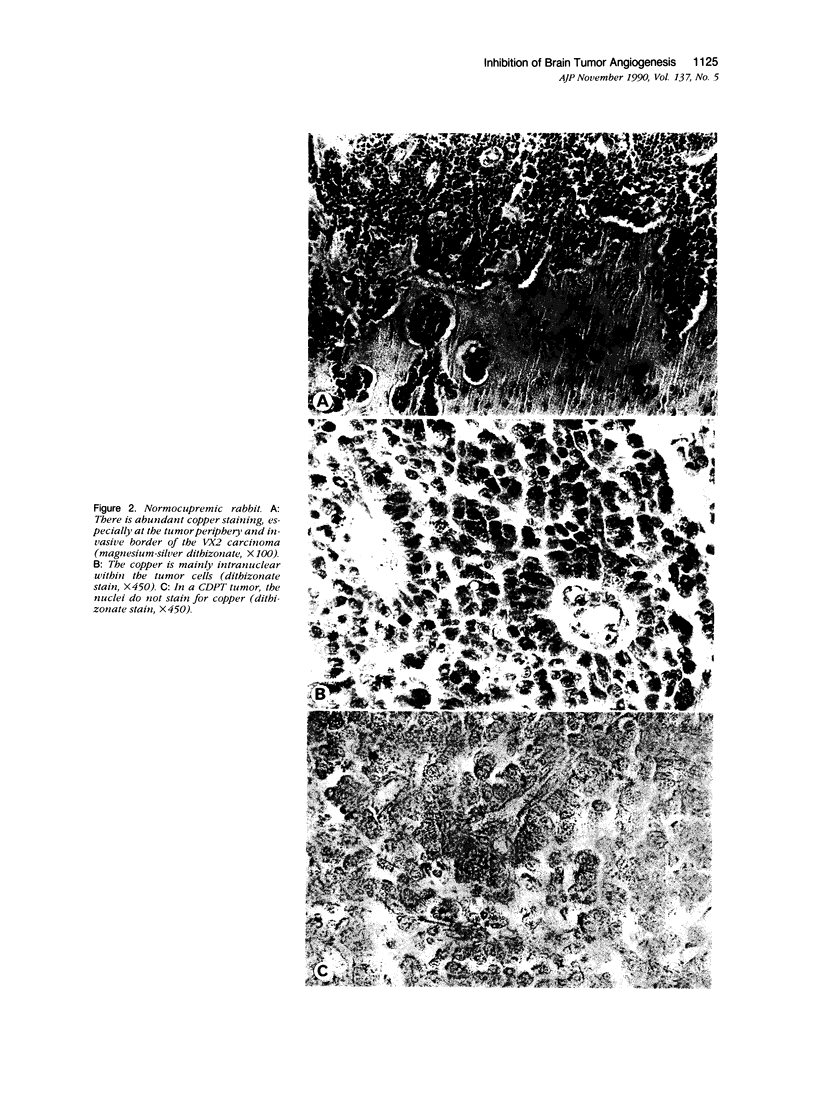
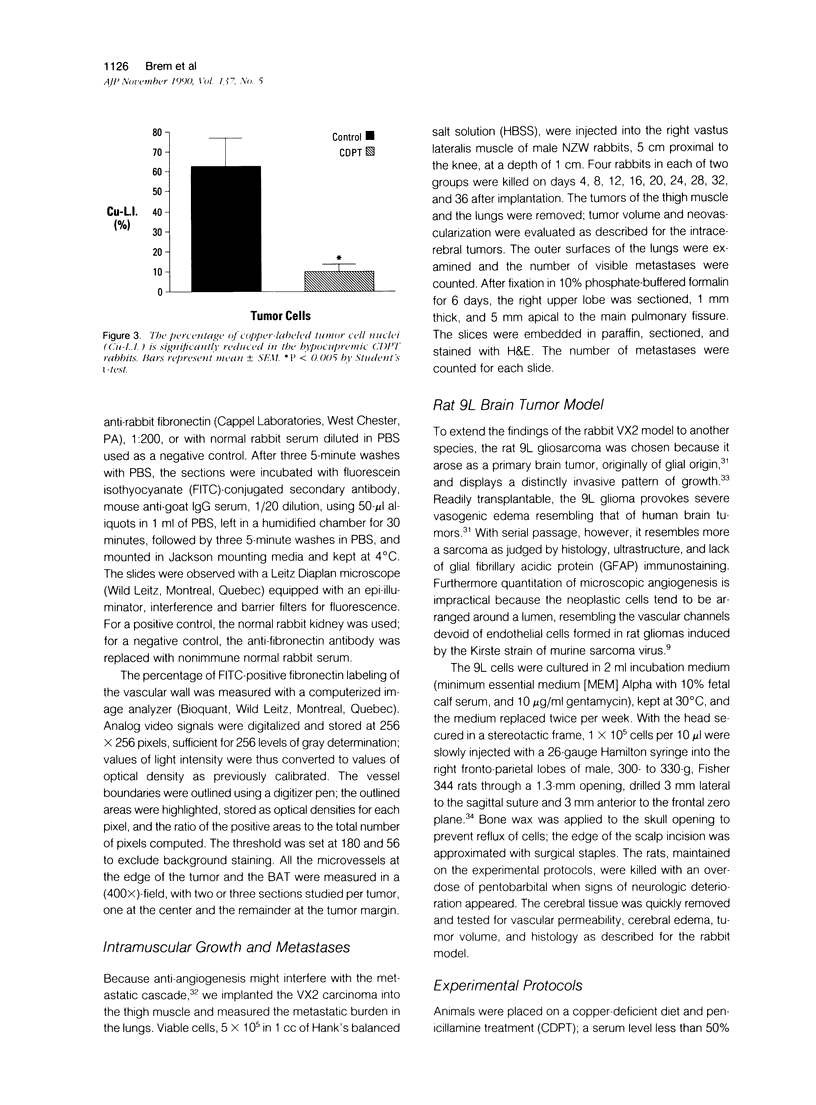

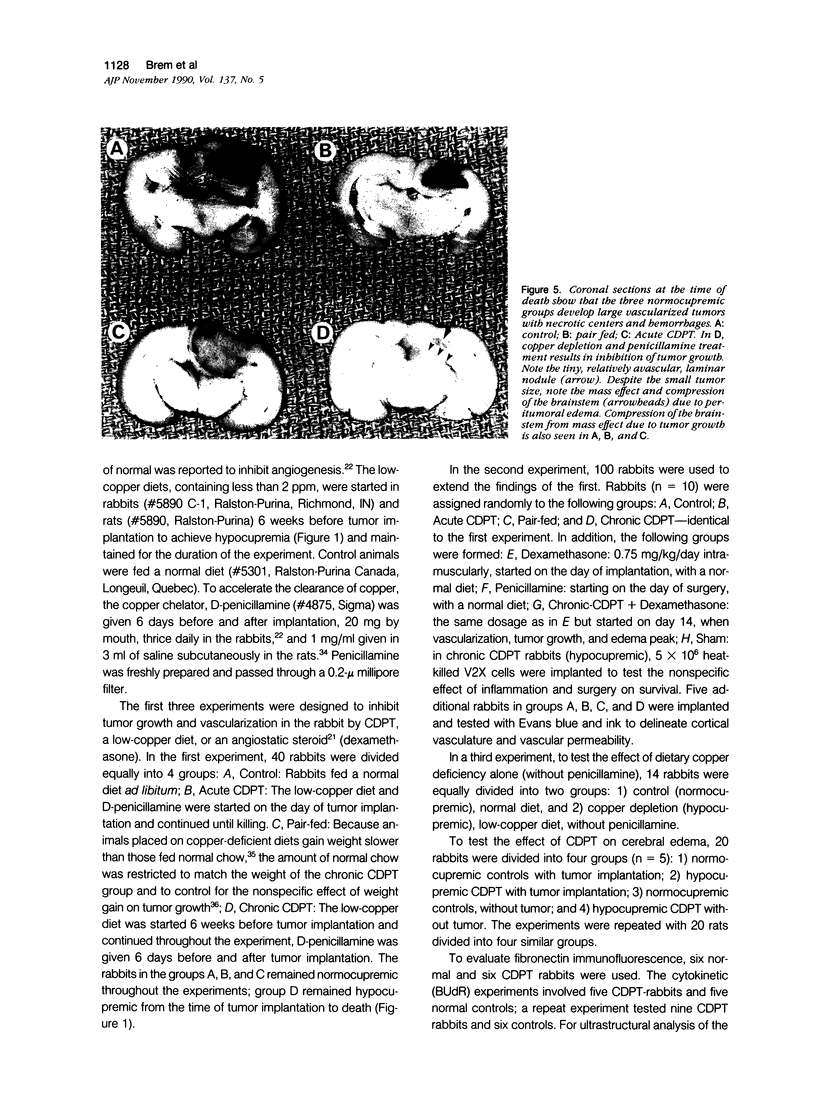
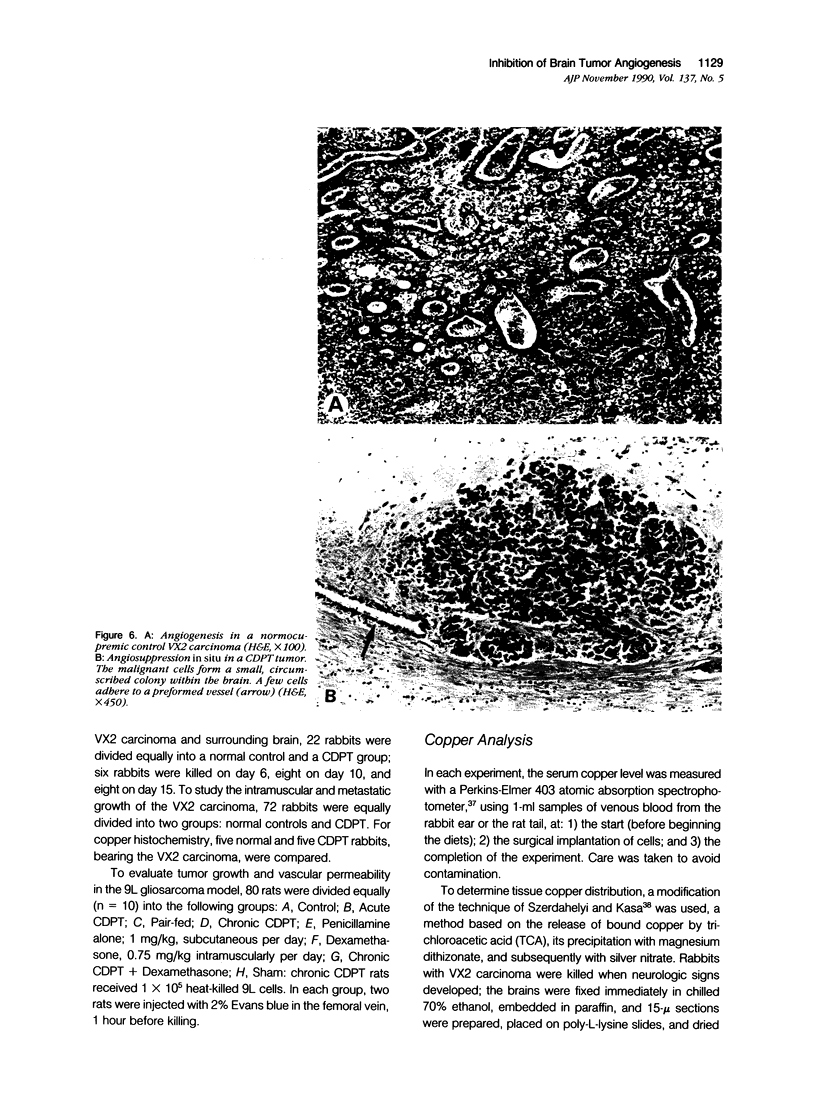
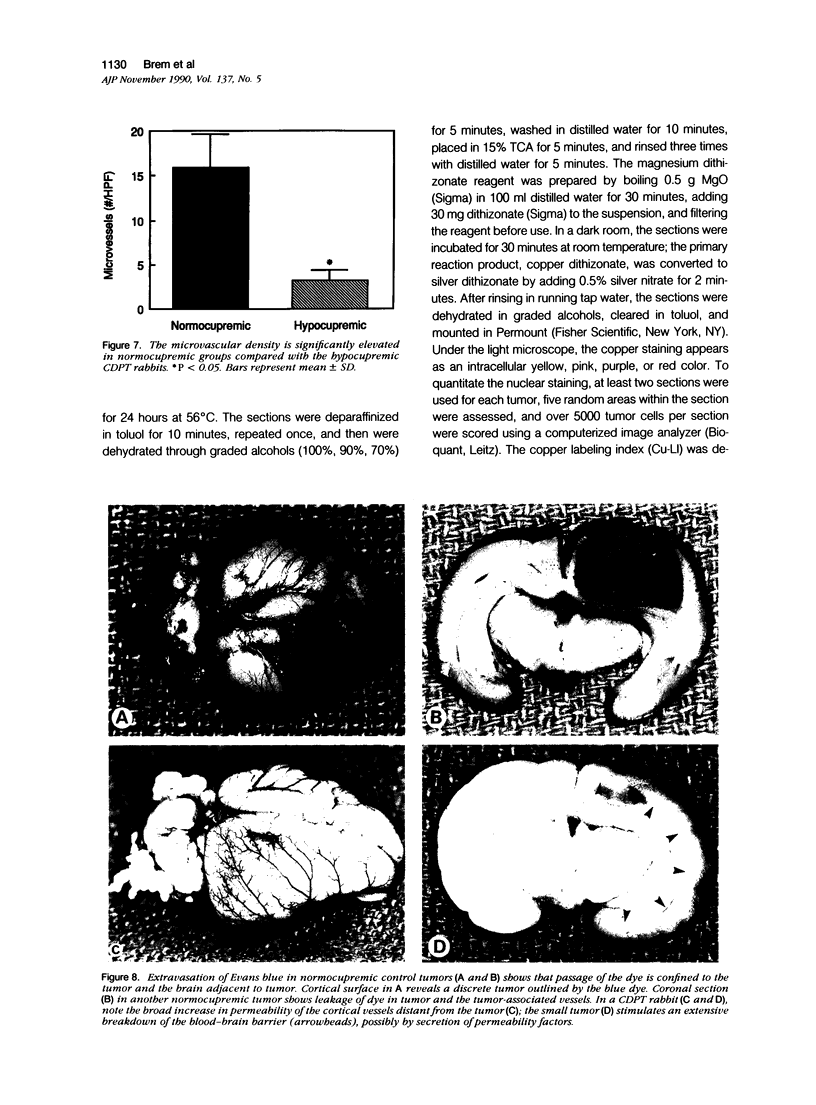
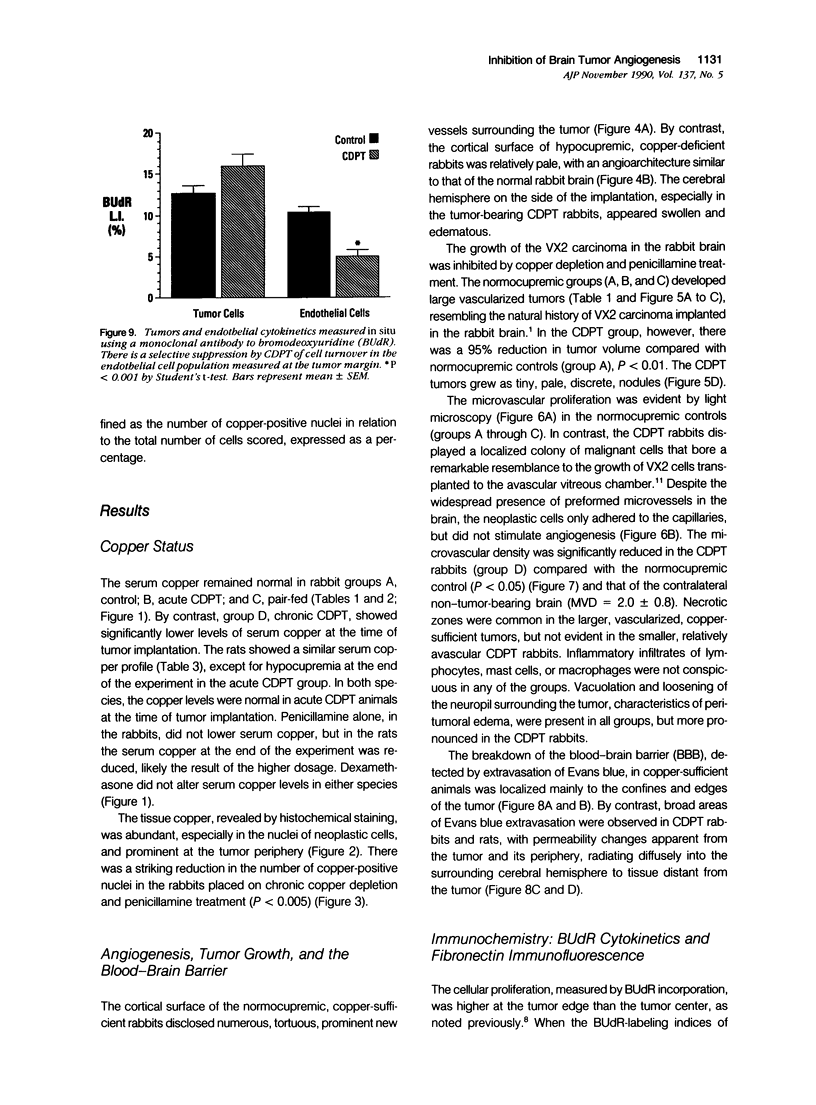
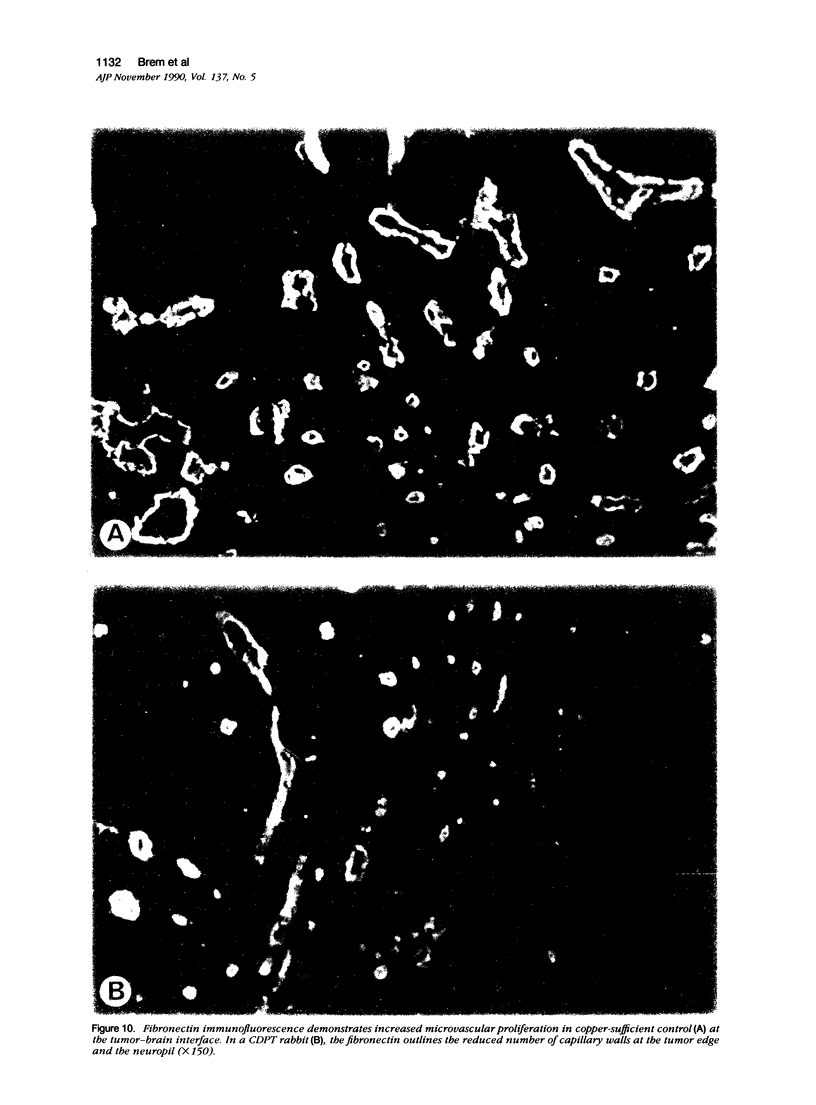
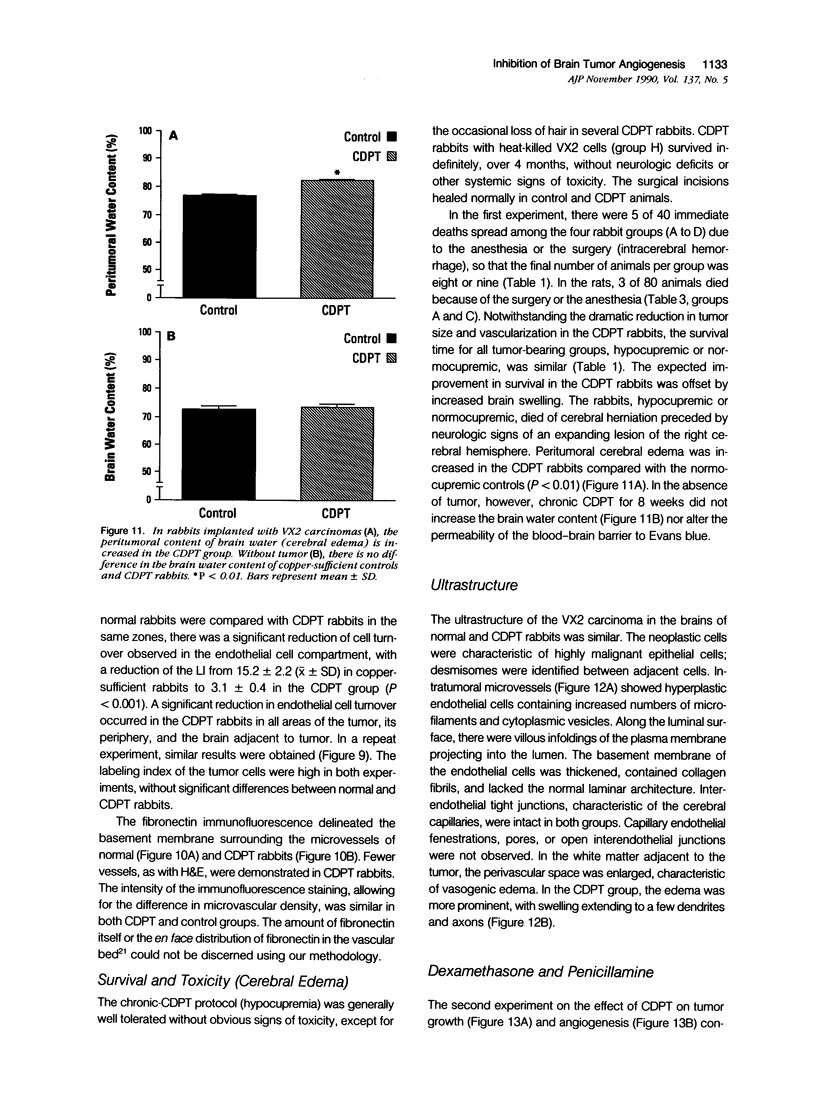
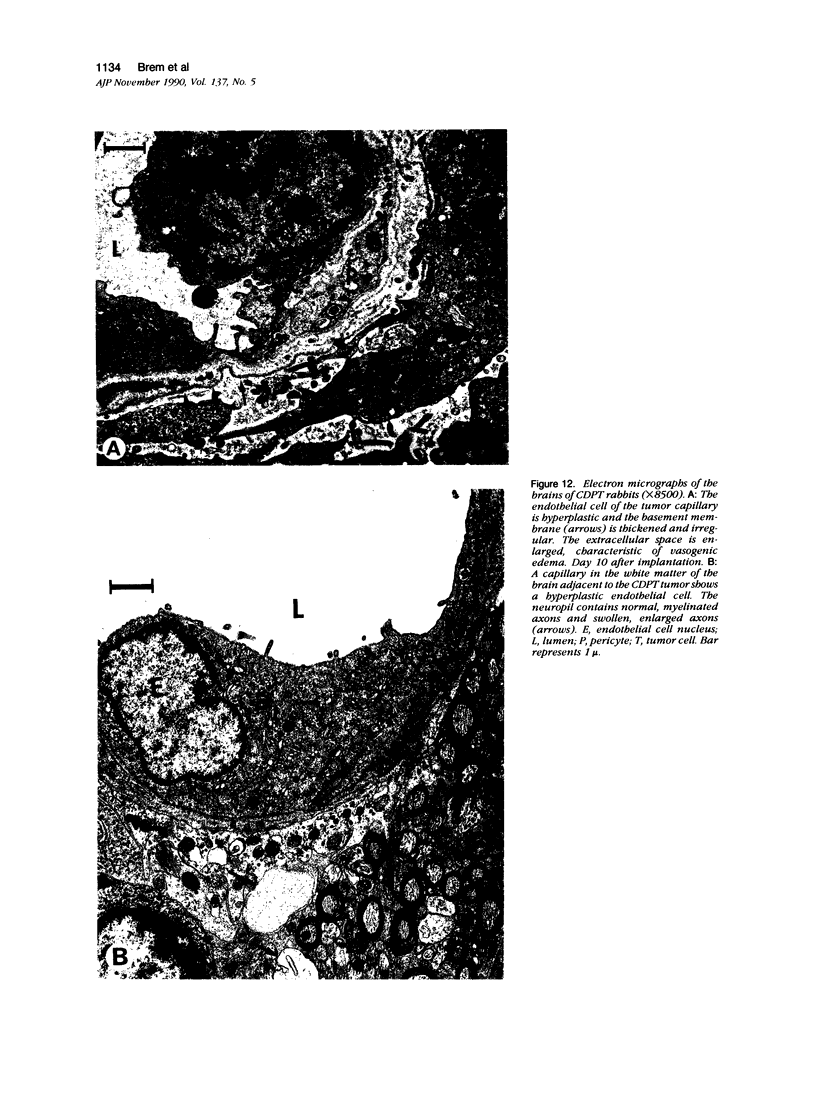

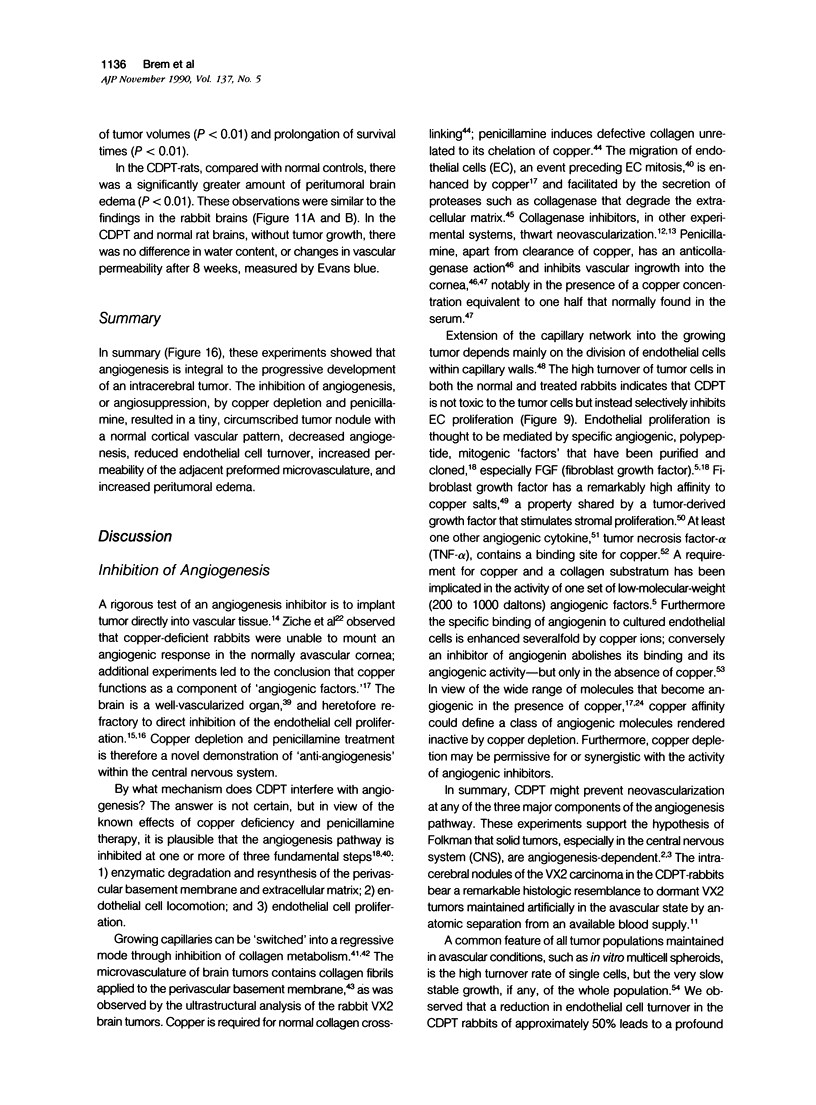
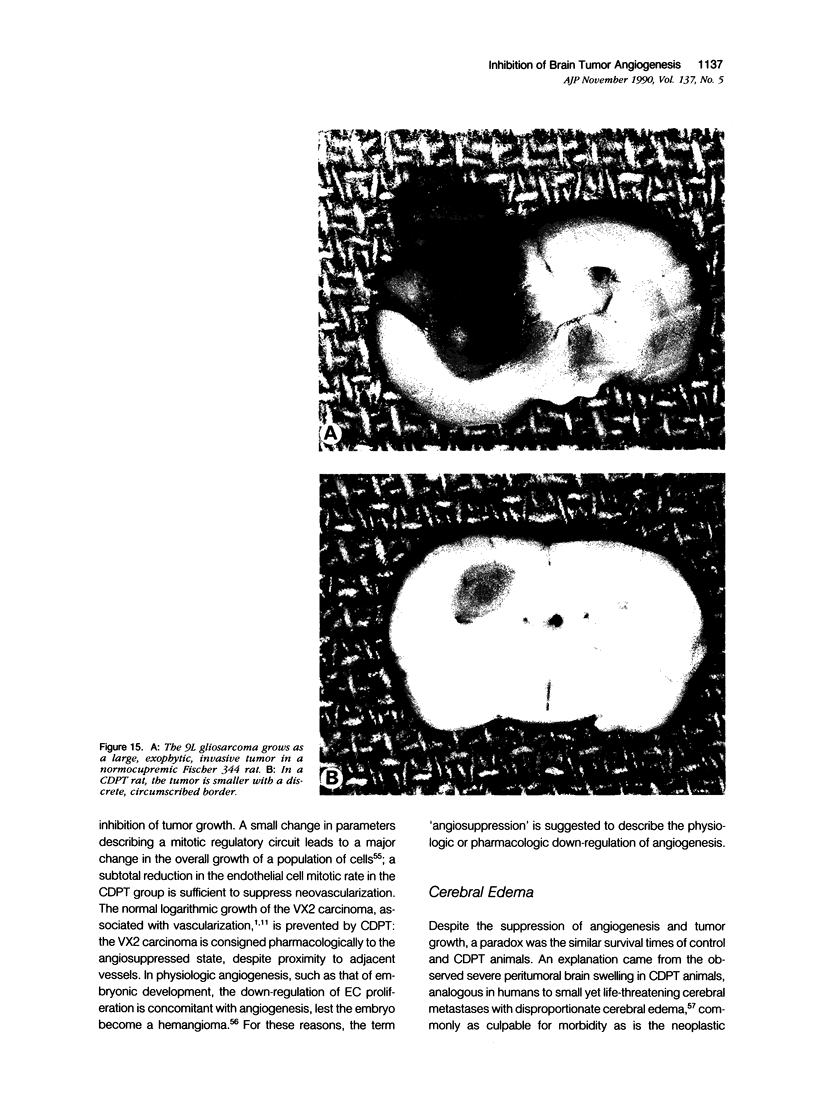

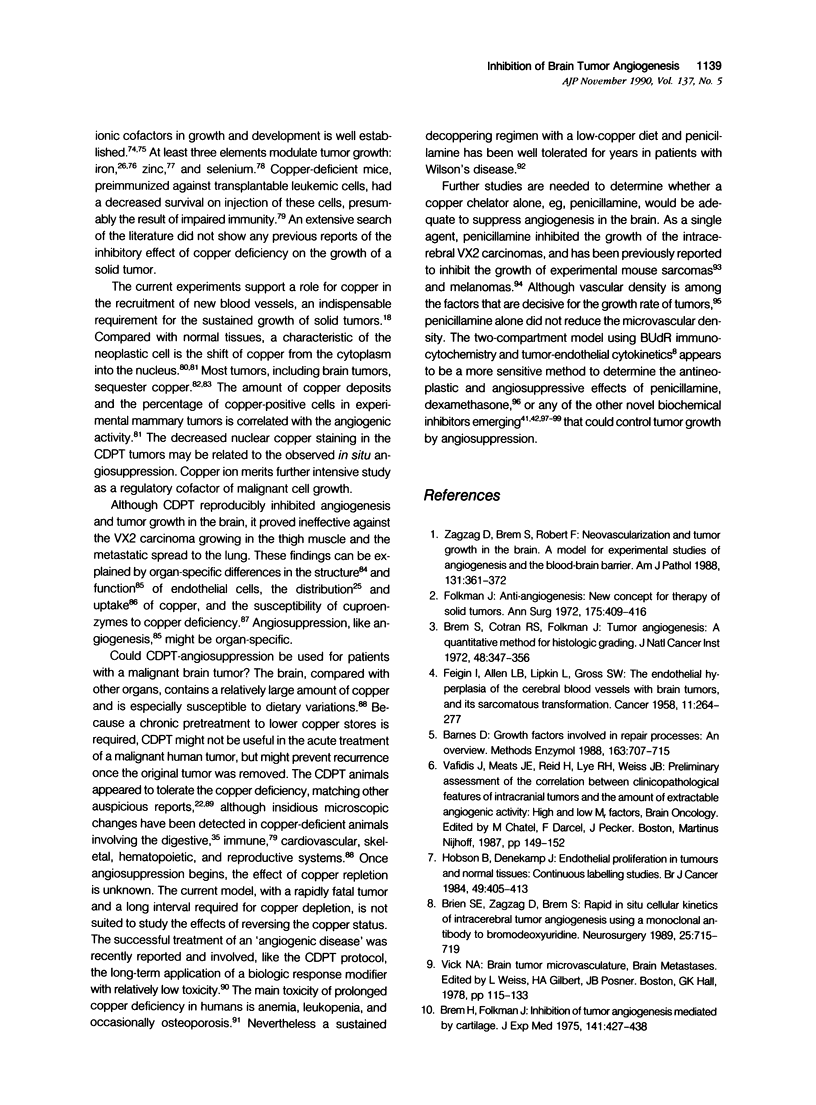
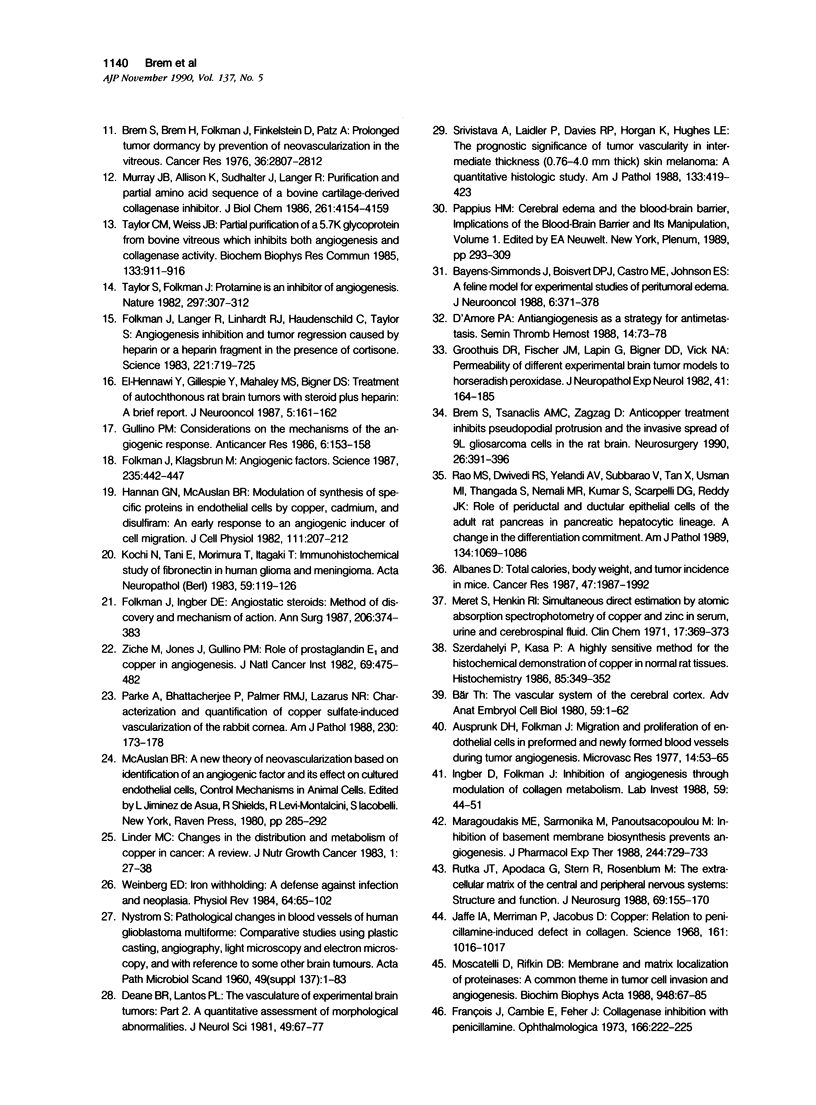
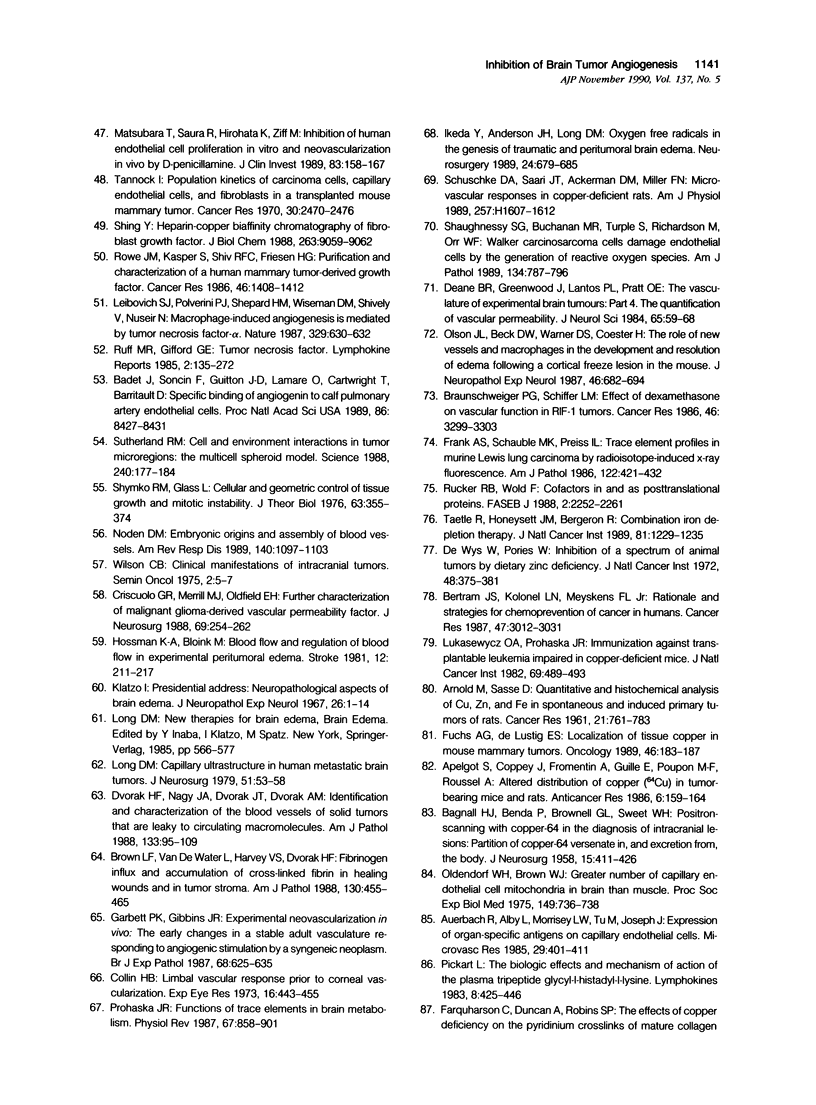
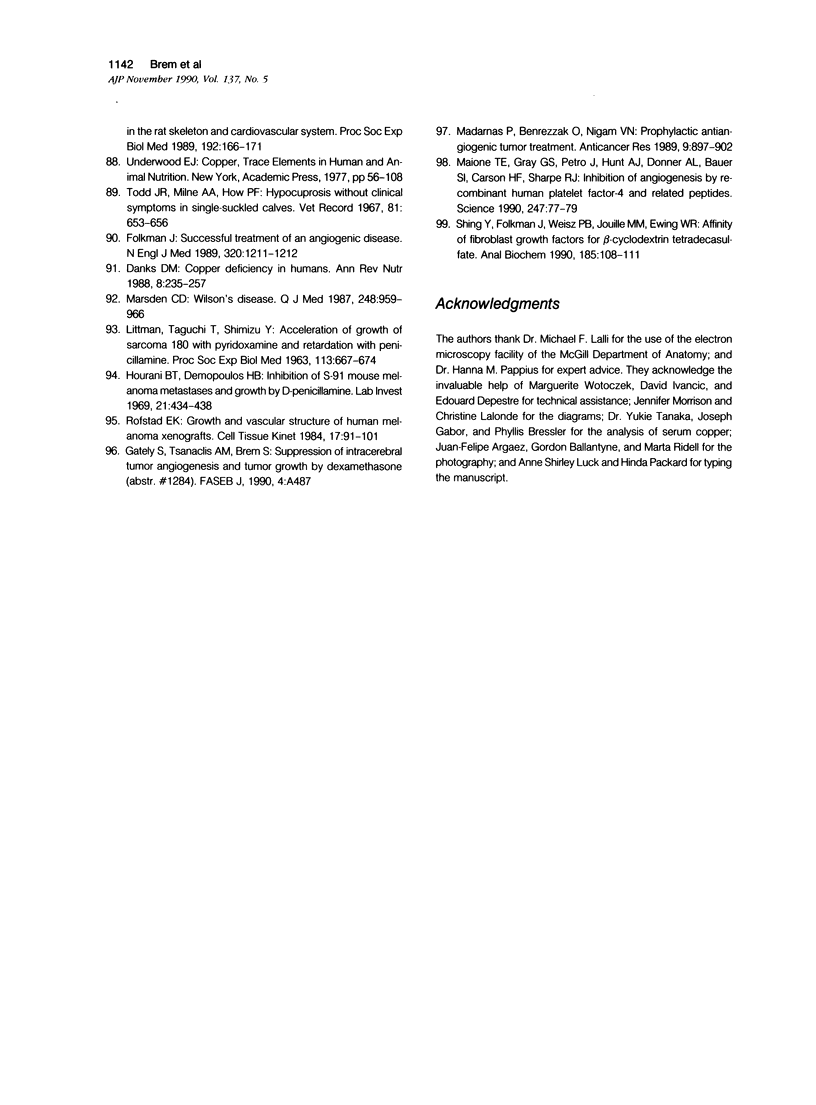
Images in this article
Selected References
These references are in PubMed. This may not be the complete list of references from this article.
- ARNOLD M., SASSE D. Quantitative and histochemical analysis of Cu, Zn, and Fe in spontaneous and induced primary tumors of rats. Cancer Res. 1961 Jul;21:761–766. [PubMed] [Google Scholar]
- Albanes D. Total calories, body weight, and tumor incidence in mice. Cancer Res. 1987 Apr 15;47(8):1987–1992. [PubMed] [Google Scholar]
- Apelgot S., Coppey J., Fromentin A., Guille E., Poupon M. F., Roussel A. Altered distribution of copper (64Cu) in tumor-bearing mice and rats. Anticancer Res. 1986 Mar-Apr;6(2):159–164. [PubMed] [Google Scholar]
- Auerbach R., Alby L., Morrissey L. W., Tu M., Joseph J. Expression of organ-specific antigens on capillary endothelial cells. Microvasc Res. 1985 May;29(3):401–411. doi: 10.1016/0026-2862(85)90028-7. [DOI] [PubMed] [Google Scholar]
- Ausprunk D. H., Folkman J. Migration and proliferation of endothelial cells in preformed and newly formed blood vessels during tumor angiogenesis. Microvasc Res. 1977 Jul;14(1):53–65. doi: 10.1016/0026-2862(77)90141-8. [DOI] [PubMed] [Google Scholar]
- BAGNALL H. J., BENDA P., BROWNELL G. L., SWEET W. H. Positron-scanning with copper-64 in the diagnosis of intracranial lesions: partition of copper-64 versenate in, and excretion from, the body. J Neurosurg. 1958 Jul;15(4):411–426. doi: 10.3171/jns.1958.15.4.0411. [DOI] [PubMed] [Google Scholar]
- Badet J., Soncin F., Guitton J. D., Lamare O., Cartwright T., Barritault D. Specific binding of angiogenin to calf pulmonary artery endothelial cells. Proc Natl Acad Sci U S A. 1989 Nov;86(21):8427–8431. doi: 10.1073/pnas.86.21.8427. [DOI] [PMC free article] [PubMed] [Google Scholar]
- Barnes D. Growth factors involved in repair processes: an overview. Methods Enzymol. 1988;163:707–715. doi: 10.1016/0076-6879(88)63058-8. [DOI] [PubMed] [Google Scholar]
- Bayens-Simmonds J., Boisvert D. P., Castro M. E., Johnson E. S. A feline model for experimental studies of peritumor brain edema. J Neurooncol. 1988 Dec;6(4):371–378. doi: 10.1007/BF00177435. [DOI] [PubMed] [Google Scholar]
- Bertram J. S., Kolonel L. N., Meyskens F. L., Jr Rationale and strategies for chemoprevention of cancer in humans. Cancer Res. 1987 Jun 1;47(11):3012–3031. [PubMed] [Google Scholar]
- Braunschweiger P. G., Schiffer L. M. Effect of dexamethasone on vascular function in RIF-1 tumors. Cancer Res. 1986 Jul;46(7):3299–3303. [PubMed] [Google Scholar]
- Brem H., Folkman J. Inhibition of tumor angiogenesis mediated by cartilage. J Exp Med. 1975 Feb 1;141(2):427–439. doi: 10.1084/jem.141.2.427. [DOI] [PMC free article] [PubMed] [Google Scholar]
- Brem S., Brem H., Folkman J., Finkelstein D., Patz A. Prolonged tumor dormancy by prevention of neovascularization in the vitreous. Cancer Res. 1976 Aug;36(8):2807–2812. [PubMed] [Google Scholar]
- Brem S., Cotran R., Folkman J. Tumor angiogenesis: a quantitative method for histologic grading. J Natl Cancer Inst. 1972 Feb;48(2):347–356. [PubMed] [Google Scholar]
- Brem S., Tsanaclis A. M., Zagzag D. Anticopper treatment inhibits pseudopodial protrusion and the invasive spread of 9L gliosarcoma cells in the rat brain. Neurosurgery. 1990 Mar;26(3):391–396. doi: 10.1097/00006123-199003000-00003. [DOI] [PubMed] [Google Scholar]
- Brien S. E., Zagzag D., Brem S. Rapid in situ cellular kinetics of intracerebral tumor angiogenesis using a monoclonal antibody to bromodeoxyuridine. Neurosurgery. 1989 Nov;25(5):715–719. doi: 10.1097/00006123-198911000-00005. [DOI] [PubMed] [Google Scholar]
- Brown L. F., Van de Water L., Harvey V. S., Dvorak H. F. Fibrinogen influx and accumulation of cross-linked fibrin in healing wounds and in tumor stroma. Am J Pathol. 1988 Mar;130(3):455–465. [PMC free article] [PubMed] [Google Scholar]
- Bär T. The vascular system of the cerebral cortex. Adv Anat Embryol Cell Biol. 1980;59:I-VI,1-62. doi: 10.1007/978-3-642-67432-7. [DOI] [PubMed] [Google Scholar]
- Collin H. B. Limbal vascular response prior to corneal vascularization. Exp Eye Res. 1973 Sep;16(6):443–455. doi: 10.1016/0014-4835(73)90101-2. [DOI] [PubMed] [Google Scholar]
- Criscuolo G. R., Merrill M. J., Oldfield E. H. Further characterization of malignant glioma-derived vascular permeability factor. J Neurosurg. 1988 Aug;69(2):254–262. doi: 10.3171/jns.1988.69.2.0254. [DOI] [PubMed] [Google Scholar]
- D'Amore P. A. Antiangiogenesis as a strategy for antimetastasis. Semin Thromb Hemost. 1988 Jan;14(1):73–78. doi: 10.1055/s-2007-1002758. [DOI] [PubMed] [Google Scholar]
- Danks D. M. Copper deficiency in humans. Annu Rev Nutr. 1988;8:235–257. doi: 10.1146/annurev.nu.08.070188.001315. [DOI] [PubMed] [Google Scholar]
- DeWys W., Pories W. Inhibition of a spectrum of animal tumors by dietary zinc deficiency. J Natl Cancer Inst. 1972 Feb;48(2):375–381. [PubMed] [Google Scholar]
- Deane B. R., Greenwood J., Lantos P. L., Pratt O. E. The vasculature of experimental brain tumours. Part 4. The quantification of vascular permeability. J Neurol Sci. 1984 Jul;65(1):59–68. doi: 10.1016/0022-510x(84)90067-4. [DOI] [PubMed] [Google Scholar]
- Deane B. R., Lantos P. L. The vasculature of experimental brain tumours. Part 2. A quantitative assessment of morphological abnormalities. J Neurol Sci. 1981 Jan;49(1):67–77. doi: 10.1016/0022-510x(81)90189-1. [DOI] [PubMed] [Google Scholar]
- Dvorak H. F., Nagy J. A., Dvorak J. T., Dvorak A. M. Identification and characterization of the blood vessels of solid tumors that are leaky to circulating macromolecules. Am J Pathol. 1988 Oct;133(1):95–109. [PMC free article] [PubMed] [Google Scholar]
- FEIGIN I., ALLEN L. B., LIPKIN L., GROSS S. W. The endothelial hyperplasia of the cerebral blood vessels with brain tumors, and its sarcomatous transformation. Cancer. 1958 Mar-Apr;11(2):264–277. doi: 10.1002/1097-0142(195803/04)11:2<264::aid-cncr2820110207>3.0.co;2-d. [DOI] [PubMed] [Google Scholar]
- Folkman J. Anti-angiogenesis: new concept for therapy of solid tumors. Ann Surg. 1972 Mar;175(3):409–416. doi: 10.1097/00000658-197203000-00014. [DOI] [PMC free article] [PubMed] [Google Scholar]
- Folkman J., Ingber D. E. Angiostatic steroids. Method of discovery and mechanism of action. Ann Surg. 1987 Sep;206(3):374–383. doi: 10.1097/00000658-198709000-00016. [DOI] [PMC free article] [PubMed] [Google Scholar]
- Folkman J., Klagsbrun M. Angiogenic factors. Science. 1987 Jan 23;235(4787):442–447. doi: 10.1126/science.2432664. [DOI] [PubMed] [Google Scholar]
- Folkman J., Langer R., Linhardt R. J., Haudenschild C., Taylor S. Angiogenesis inhibition and tumor regression caused by heparin or a heparin fragment in the presence of cortisone. Science. 1983 Aug 19;221(4612):719–725. doi: 10.1126/science.6192498. [DOI] [PubMed] [Google Scholar]
- Folkman J. Successful treatment of an angiogenic disease. N Engl J Med. 1989 May 4;320(18):1211–1212. doi: 10.1056/NEJM198905043201811. [DOI] [PubMed] [Google Scholar]
- Frank A. S., Schauble M. K., Preiss I. L. Trace element profiles in murine Lewis lung carcinoma by radioisotope-induced X-ray fluorescence. Am J Pathol. 1986 Mar;122(3):421–432. [PMC free article] [PubMed] [Google Scholar]
- François J., Cambie E., Feher J. Collagenase inhibition with penicillamine. Case report. Ophthalmologica. 1973;166(3):222–225. doi: 10.1159/000306814. [DOI] [PubMed] [Google Scholar]
- Fuchs A. G., de Lustig E. S. Localization of tissue copper in mouse mammary tumors. Oncology. 1989;46(3):183–187. doi: 10.1159/000226711. [DOI] [PubMed] [Google Scholar]
- Garbett P. K., Gibbins J. R. Experimental neovascularization in vivo: the early changes in a stable adult vasculature responding to angiogenic stimulation by a syngeneic neoplasm. Br J Exp Pathol. 1987 Oct;68(5):625–635. [PMC free article] [PubMed] [Google Scholar]
- Groothuis D. R., Fischer J. M., Lapin G., Bigner D. D., Vick N. A. Permeability of different experimental brain tumor models to horseradish peroxidase. J Neuropathol Exp Neurol. 1982 Mar;41(2):164–185. doi: 10.1097/00005072-198203000-00006. [DOI] [PubMed] [Google Scholar]
- Gullino P. M. Considerations on the mechanism of the angiogenic response. Anticancer Res. 1986 Mar-Apr;6(2):153–158. [PubMed] [Google Scholar]
- Hannan G. N., McAuslan B. R. Modulation of synthesis of specific proteins in endothelial cells by copper, cadmium, and disulfiram: an early response to an angiogenic inducer of cell migration. J Cell Physiol. 1982 May;111(2):207–212. doi: 10.1002/jcp.1041110213. [DOI] [PubMed] [Google Scholar]
- Hobson B., Denekamp J. Endothelial proliferation in tumours and normal tissues: continuous labelling studies. Br J Cancer. 1984 Apr;49(4):405–413. doi: 10.1038/bjc.1984.66. [DOI] [PMC free article] [PubMed] [Google Scholar]
- Hossman K. A., Blöink M. Blood flow and regulation of blood flow in experimental peritumoral edema. Stroke. 1981 Mar-Apr;12(2):211–217. doi: 10.1161/01.str.12.2.211. [DOI] [PubMed] [Google Scholar]
- Hourani B. T., Demopoulos H. B. Inhibition of S-91 mouse melanoma metastases and growth by D-penicillamine. Lab Invest. 1969 Nov;21(5):434–438. [PubMed] [Google Scholar]
- Ikeda Y., Anderson J. H., Long D. M. Oxygen free radicals in the genesis of traumatic and peritumoral brain edema. Neurosurgery. 1989 May;24(5):679–685. doi: 10.1227/00006123-198905000-00004. [DOI] [PubMed] [Google Scholar]
- Ingber D., Folkman J. Inhibition of angiogenesis through modulation of collagen metabolism. Lab Invest. 1988 Jul;59(1):44–51. [PubMed] [Google Scholar]
- Jaffe I. A., Merriman P., Jacobus D. Copper: relation to penicillamine-induced defect in collagen. Science. 1968 Sep 6;161(3845):1016–1017. doi: 10.1126/science.161.3845.1016. [DOI] [PubMed] [Google Scholar]
- Klatzo I. Presidental address. Neuropathological aspects of brain edema. J Neuropathol Exp Neurol. 1967 Jan;26(1):1–14. doi: 10.1097/00005072-196701000-00001. [DOI] [PubMed] [Google Scholar]
- Kochi N., Tani E., Morimura T., Itagaki T. Immunohistochemical study of fibronectin in human glioma and meningioma. Acta Neuropathol. 1983;59(2):119–126. doi: 10.1007/BF00691597. [DOI] [PubMed] [Google Scholar]
- LITTMAN M. L., TAGUCHI T., SHIMIZU Y. Acceleration of growth of sarcoma 180 with pyridoxamine and retardation with penicillamine. Proc Soc Exp Biol Med. 1963 Jul;113:667–674. doi: 10.3181/00379727-113-28458. [DOI] [PubMed] [Google Scholar]
- Leibovich S. J., Polverini P. J., Shepard H. M., Wiseman D. M., Shively V., Nuseir N. Macrophage-induced angiogenesis is mediated by tumour necrosis factor-alpha. Nature. 1987 Oct 15;329(6140):630–632. doi: 10.1038/329630a0. [DOI] [PubMed] [Google Scholar]
- Long D. M. Capillary ultrastructure in human metastatic brain tumors. J Neurosurg. 1979 Jul;51(1):53–58. doi: 10.3171/jns.1979.51.1.0053. [DOI] [PubMed] [Google Scholar]
- Lukasewycz O. A., Prohaska J. R. Immunization against transplantable leukemia impaired in copper-deficient mice. J Natl Cancer Inst. 1982 Aug;69(2):489–493. [PubMed] [Google Scholar]
- Madarnas P., Benrezzak O., Nigam V. N. Prophylactic antiangiogenic tumor treatment. Anticancer Res. 1989 Jul-Aug;9(4):897–901. [PubMed] [Google Scholar]
- Maione T. E., Gray G. S., Petro J., Hunt A. J., Donner A. L., Bauer S. I., Carson H. F., Sharpe R. J. Inhibition of angiogenesis by recombinant human platelet factor-4 and related peptides. Science. 1990 Jan 5;247(4938):77–79. doi: 10.1126/science.1688470. [DOI] [PubMed] [Google Scholar]
- Maragoudakis M. E., Sarmonika M., Panoutsacopoulou M. Inhibition of basement membrane biosynthesis prevents angiogenesis. J Pharmacol Exp Ther. 1988 Feb;244(2):729–733. [PubMed] [Google Scholar]
- Marsden C. D. Wilson's disease. Q J Med. 1987 Dec;65(248):959–966. [PubMed] [Google Scholar]
- Matsubara T., Saura R., Hirohata K., Ziff M. Inhibition of human endothelial cell proliferation in vitro and neovascularization in vivo by D-penicillamine. J Clin Invest. 1989 Jan;83(1):158–167. doi: 10.1172/JCI113853. [DOI] [PMC free article] [PubMed] [Google Scholar]
- Meret S., Henkin R. I. Simultaneous direct estimation by atomic absorption spectrophotometry of copper and zinc in serum, urine, and cerebrospinal fluid. Clin Chem. 1971 May;17(5):369–373. [PubMed] [Google Scholar]
- Moscatelli D., Rifkin D. B. Membrane and matrix localization of proteinases: a common theme in tumor cell invasion and angiogenesis. Biochim Biophys Acta. 1988 Aug 3;948(1):67–85. doi: 10.1016/0304-419x(88)90005-4. [DOI] [PubMed] [Google Scholar]
- Murray J. B., Allison K., Sudhalter J., Langer R. Purification and partial amino acid sequence of a bovine cartilage-derived collagenase inhibitor. J Biol Chem. 1986 Mar 25;261(9):4154–4159. [PubMed] [Google Scholar]
- NYSTROM S. Pathological changes in blood vessels of human glioblastoma multiforme. Comparative studies using plastic casting, angiography, light microscopy and electron microscopy, and with reference to some other brain tumours. Acta Pathol Microbiol Scand Suppl. 1960;49(Suppl 137):1–83. [PubMed] [Google Scholar]
- Noden D. M. Embryonic origins and assembly of blood vessels. Am Rev Respir Dis. 1989 Oct;140(4):1097–1103. doi: 10.1164/ajrccm/140.4.1097. [DOI] [PubMed] [Google Scholar]
- Oldendorf W. H., Brown W. J. Greater number of capillary endothelial cell mitochondria in brain than in muscle. Proc Soc Exp Biol Med. 1975 Jul;149(3):736–738. doi: 10.3181/00379727-149-38889. [DOI] [PubMed] [Google Scholar]
- Olson J. J., Beck D. W., Warner D. S., Coester H. The role of new vessels and macrophages in the development and resolution of edema following a cortical freeze lesion in the mouse. J Neuropathol Exp Neurol. 1987 Nov;46(6):682–694. doi: 10.1097/00005072-198711000-00007. [DOI] [PubMed] [Google Scholar]
- Parke A., Bhattacherjee P., Palmer R. M., Lazarus N. R. Characterization and quantification of copper sulfate-induced vascularization of the rabbit cornea. Am J Pathol. 1988 Jan;130(1):173–178. [PMC free article] [PubMed] [Google Scholar]
- Prohaska J. R. Functions of trace elements in brain metabolism. Physiol Rev. 1987 Jul;67(3):858–901. doi: 10.1152/physrev.1987.67.3.858. [DOI] [PubMed] [Google Scholar]
- Rao M. S., Dwivedi R. S., Yeldandi A. V., Subbarao V., Tan X. D., Usman M. I., Thangada S., Nemali M. R., Kumar S., Scarpelli D. G. Role of periductal and ductular epithelial cells of the adult rat pancreas in pancreatic hepatocyte lineage. A change in the differentiation commitment. Am J Pathol. 1989 May;134(5):1069–1086. [PMC free article] [PubMed] [Google Scholar]
- Rofstad E. K. Growth and vascular structure of human melanoma xenografts. Cell Tissue Kinet. 1984 Jan;17(1):91–101. doi: 10.1111/j.1365-2184.1984.tb00571.x. [DOI] [PubMed] [Google Scholar]
- Rowe J. M., Kasper S., Shiu R. P., Friesen H. G. Purification and characterization of a human mammary tumor-derived growth factor. Cancer Res. 1986 Mar;46(3):1408–1412. [PubMed] [Google Scholar]
- Rucker R. B., Wold F. Cofactors in and as posttranslational protein modifications. FASEB J. 1988 Apr;2(7):2252–2261. doi: 10.1096/fasebj.2.7.3127264. [DOI] [PubMed] [Google Scholar]
- Rutka J. T., Apodaca G., Stern R., Rosenblum M. The extracellular matrix of the central and peripheral nervous systems: structure and function. J Neurosurg. 1988 Aug;69(2):155–170. doi: 10.3171/jns.1988.69.2.0155. [DOI] [PubMed] [Google Scholar]
- Shaughnessy S. G., Buchanan M. R., Turple S., Richardson M., Orr F. W. Walker carcinosarcoma cells damage endothelial cells by the generation of reactive oxygen species. Am J Pathol. 1989 Apr;134(4):787–796. [PMC free article] [PubMed] [Google Scholar]
- Shing Y. Heparin-copper biaffinity chromatography of fibroblast growth factors. J Biol Chem. 1988 Jun 25;263(18):9059–9062. [PubMed] [Google Scholar]
- Shymko R. M. Cellular and geometric control of tissue growth and mitotic instability. J Theor Biol. 1976 Dec;63(2):355–374. doi: 10.1016/0022-5193(76)90039-4. [DOI] [PubMed] [Google Scholar]
- Srivastava A., Laidler P., Davies R. P., Horgan K., Hughes L. E. The prognostic significance of tumor vascularity in intermediate-thickness (0.76-4.0 mm thick) skin melanoma. A quantitative histologic study. Am J Pathol. 1988 Nov;133(2):419–423. [PMC free article] [PubMed] [Google Scholar]
- Sutherland R. M. Cell and environment interactions in tumor microregions: the multicell spheroid model. Science. 1988 Apr 8;240(4849):177–184. doi: 10.1126/science.2451290. [DOI] [PubMed] [Google Scholar]
- Szerdahelyi P., Kása P. A highly sensitive method for the histochemical demonstration of copper in normal rat tissues. Histochemistry. 1986;85(4):349–352. doi: 10.1007/BF00493488. [DOI] [PubMed] [Google Scholar]
- Taetle R., Honeysett J. M., Bergeron R. Combination iron depletion therapy. J Natl Cancer Inst. 1989 Aug 16;81(16):1229–1235. doi: 10.1093/jnci/81.16.1229. [DOI] [PubMed] [Google Scholar]
- Tannock I. F. Population kinetics of carcinoma cells, capillary endothelial cells, and fibroblasts in a transplanted mouse mammary tumor. Cancer Res. 1970 Oct;30(10):2470–2476. [PubMed] [Google Scholar]
- Taylor C. M., Weiss J. B. Partial purification of a 5.7K glycoprotein from bovine vitreous which inhibits both angiogenesis and collagenase activity. Biochem Biophys Res Commun. 1985 Dec 31;133(3):911–916. doi: 10.1016/0006-291x(85)91222-7. [DOI] [PubMed] [Google Scholar]
- Taylor S., Folkman J. Protamine is an inhibitor of angiogenesis. Nature. 1982 May 27;297(5864):307–312. doi: 10.1038/297307a0. [DOI] [PubMed] [Google Scholar]
- Todd J. R., Milne A. A., How P. F. Hypocuprosis without clinical symptoms in single-sucked calves. Vet Rec. 1967 Dec 16;81(25):653–656. doi: 10.1136/vr.81.25.653. [DOI] [PubMed] [Google Scholar]
- Weinberg E. D. Iron withholding: a defense against infection and neoplasia. Physiol Rev. 1984 Jan;64(1):65–102. doi: 10.1152/physrev.1984.64.1.65. [DOI] [PubMed] [Google Scholar]
- Wilson C. B. Clinical manifestations of intracranial tumors. Semin Oncol. 1975 Mar;2(1):5–7. [PubMed] [Google Scholar]
- Yuen S. N., Folkman J., Weisz P. B., Joullie M. M., Ewing W. R. Affinity of fibroblast growth factors for beta-cyclodextrin tetradecasulfate. Anal Biochem. 1990 Feb 15;185(1):108–111. doi: 10.1016/0003-2697(90)90263-9. [DOI] [PubMed] [Google Scholar]
- Zagzag D., Brem S., Robert F. Neovascularization and tumor growth in the rabbit brain. A model for experimental studies of angiogenesis and the blood-brain barrier. Am J Pathol. 1988 May;131(2):361–372. [PMC free article] [PubMed] [Google Scholar]
- Ziche M., Jones J., Gullino P. M. Role of prostaglandin E1 and copper in angiogenesis. J Natl Cancer Inst. 1982 Aug;69(2):475–482. [PubMed] [Google Scholar]
- el-Hennawi Y., Gillespie G. Y., Mahaley M. S., Bigner D. D. Treatment of autochthonous rat brain tumors with steroid plus heparin: a brief report. J Neurooncol. 1987;5(2):161–162. doi: 10.1007/BF02571304. [DOI] [PubMed] [Google Scholar]




